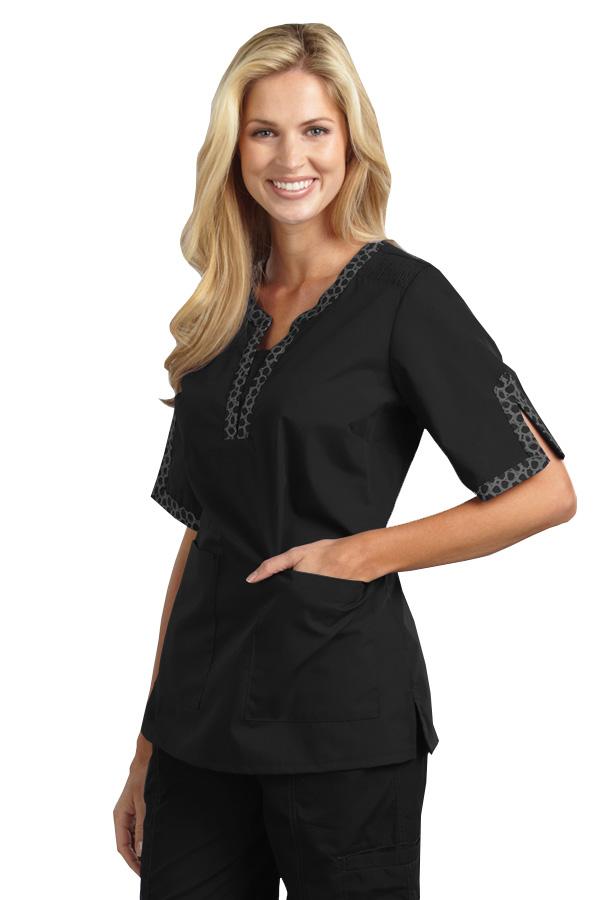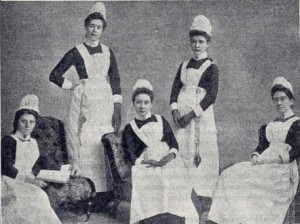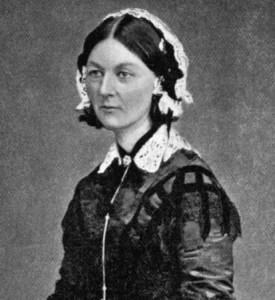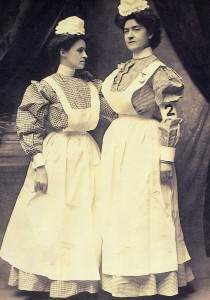When you think of a nurse, what image comes immediately to mind? A lady in a crisp white frock, with a starched white cloth apron in her hair, wearing white rubber shoes, white socks and white belt; the quintessential image of standard nursing uniform for nurses worldwide. However, the concept of nursing uniforms has changed now, with nurses wearing scrub sets and other flexible clothing.
Still, it’s the everlasting image of the perfect nurse in her pristine, starched white uniform that remains with us. Wouldn’t you like to know more about how the white nursing uniform came about? What’s the history of the nursing uniform? We have put together a few facts gathered from the pages of history for you to read, in this article.
Nursing Uniforms In The 19thCentury
Nurses in this era wore servants’ uniforms, which consisted of a full black or printed gown with a white gathered or banded cap and a white apron. Nursing was still a street profession, though some nurses worked as private health caretakers for wealthy households.
People started feeling a greater need for nurses around 1840 and nursing as a career started gaining more respect. Nurses were trained to some extent and made to work at city or local health board. these nurses did not wear servants’ uniforms; rather, they wore ladylike gowns with white aprons and caps to indicate that they were nurses. The starched white cap became synonymous with the nursing profession at about this time.
Florence Nightingale paved the way for the ultimate recognition of nursing as a superior, compassionate profession. Nursing in the post Nightingale era turned into a more respectable job, with schooling systems and uniforms for nurses. Nurses had to wear a hat and band to distinguish themselves as nurses and display their nursing rank. Fresh nurse students would wear ribbon bands of pink, blue, or other pastel colors. Senior nurses and nursing teachers would wear black ribbon bands to indicate seniority.
Nursing Uniforms In The 20th Century
In the 1900s, nursing uniforms started looking distinctly different from servant uniforms. Nursing uniforms came with pockets for keeping things on hand, a button down style top and pointy collars that differentiated them from other clothing. A white bib covered the nurse’s torso till the waist, where the bib’s folds were gathered and let down as an apron.
The nurse’s dress was made of solid color fabric, and was tailored well. The tailoring, the style effects, the pockets and bib aprons ensured that the nurse would not be confused with a regular domestic servant.
Nurses started wearing large hats in emulation of a nun’s starched high hat and veil. Emulating a nun’s uniform brought the nursing uniform a further semblance of borrowed respectability. Sometimes nuns used to operate as nurses and nurses opted to become nuns and serve in the nursing field. Therefore, many churches had trained nurses who would be asked to help during times of sickness and community diseases.
The First World War brought about great changes in the nursing uniform. Design aspects and distinction took a back seat, and functionality became the most important feature in a nurse’s uniform. Nurses had to be fast and provide quick care for the many casualties they had to tend during the war. Sleeves were rolled up for easier movement, bulky aprons were taken off and shirts shortened for convenience. After the first world war that nurses realized they needed a uniform that combined functionality with femininity. The resultant look is the precedent of the white nurse’s uniform that we know as the standard nursing image now.

By the 1950s, paper hats and simple folded hats replaced the large, elaborate crown-like caps that were worn by nurses during the first world war. The simple paper hats were more comfortable. The policy to use hats to denote seniority level was abolished, since the morality of nurses was affected by the discrimination. Dresses also evolved, since no one has the time to launder elaborately tailored clothing anymore. Dresses became less form fitting and were easy to wash, iron and wear.

The nursing hat disappeared completely in the US by the late 1970s. male nurses started wearing nursing scrubs, which soon became the new fashion trend. Nursing uniforms started to resemble regular clothing and nurses appreciated the informal and casual feel of the clothes.
Nursing Uniforms Today

Today, only name tags differentiate nurses from doctors and other staff. Most medical staff wear nursing scrubs at all times to prevent the spread of infectious diseases. Health care centers sometimes specify different colors or patterns for the scrubs worn by nurses and doctors. Other than this, the scrubs are usually of loose drawstring pants coupled with casual V-neck t-shirts. Nursing scrubs are now available in many colors, patterns and fabrics.


